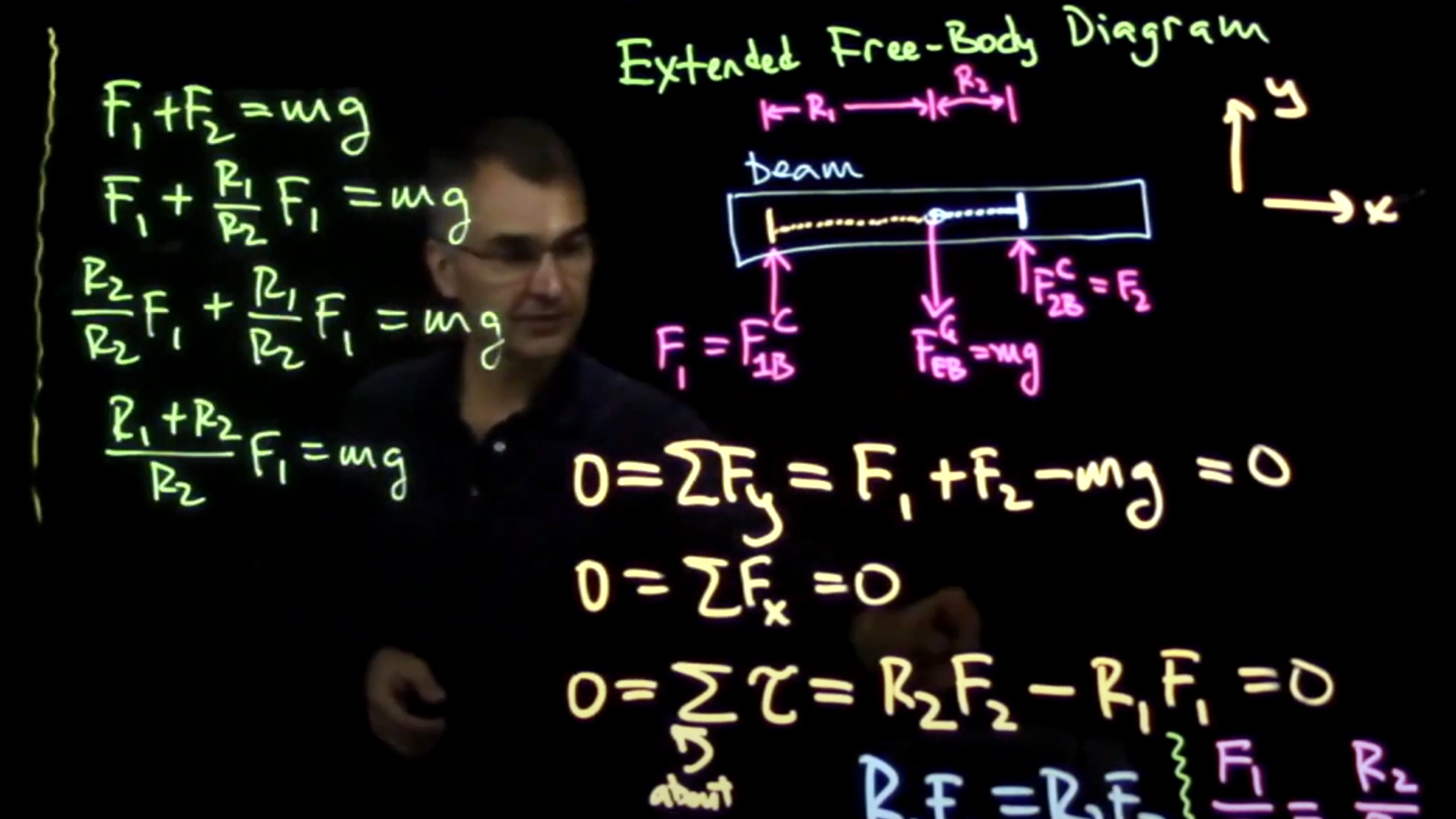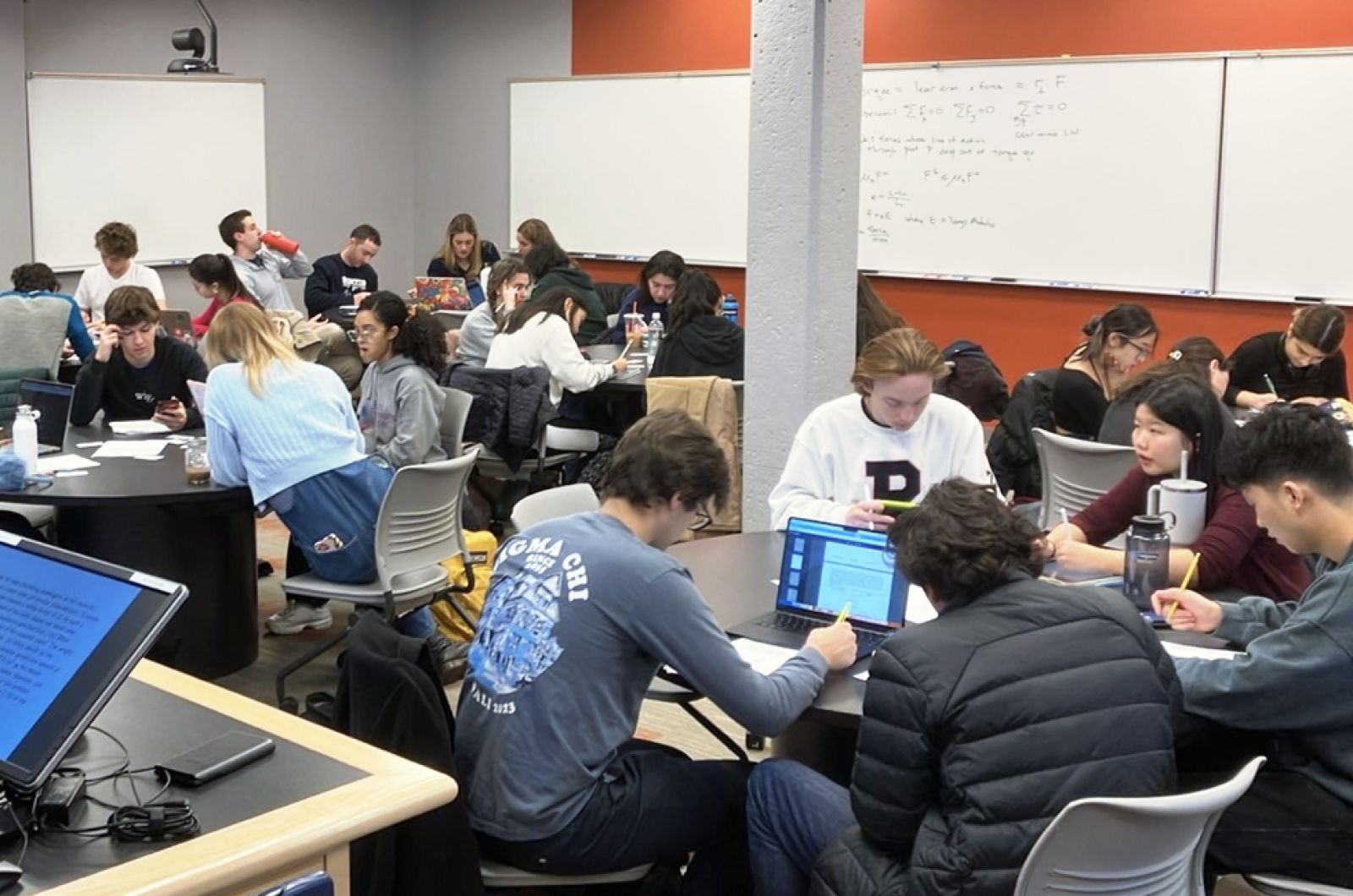How a Flipped Classroom Stokes the Collaborative Spirit of Physics
Bill Ashmanskas is using the Structured Active In-Class Learning format to help his students grasp high-level physics concepts.

In a prerecorded lecture for his Physics in Architecture class, Bill Ashmanskas goes over calculations that students will later discuss together in class. (Image: Courtesy Bill Ashmanskas)
Bill Ashmanskas’s classroom is loud, and he likes it that way. On any given day, his Physics for Architects students might cheer as they successfully launch a ball through a series of tiny hoops in a model of projectile motion, or chat among themselves as they solve problem sets. What’s less likely is to hear Ashmanskas, a senior lecturer in the Department of Physics and Astronomy, lecturing in the traditional sense of the word; other than a short review at the beginning of class, he turns the room over to his students.
That’s because since 2020, Physics for Architects has been a Structured Active In-class Learning (SAIL) course. It uses what some call a “flipped classroom” format, in which students prepare outside of class, then spend their time together engaged in active learning activities. Introduced at Penn in 2012, the practice was first adopted by professors in the physics and chemistry departments, but it has proliferated to departments across the university. SAIL courses are now a staple of the physics department, which has its own SAIL coordinator and many professors who’ve embraced the format.
Making Physics Less Intimidating
Physics for Architects is an introductory course designed to familiarize architecture majors with key physics concepts or offer non-majors an engaging elective to fulfill their graduation requirements. The course emphasizes fundamental ideas like forces, vectors, and torques.
Before each class, students learn those concepts through video lectures that Ashmanskas meticulously prepares. He discusses well-known case studies like the Kansas City Hyatt Regency skywalk collapse, drawing diagrams of what went wrong with the building, then climbing on a rope hanging from the ceiling to show how precariously the skywalk was dangling from its supports. Once in class, students hammer home the concepts by solving problems in small groups.
“Many, many research studies suggest that courses with highly structured, highly active learning produce better learning outcomes for all students,” says Bruce Lenthall, executive director of Penn’s Center for Excellence in Teaching, Learning and Innovation (CETLI), who has helped implement SAIL courses at Penn for more than a decade. He says the courses also help engage students who have been historically underrepresented in their field, improving opportunities for equitable learning.
Though Ashmanskas says some students still prefer traditional lectures, he’s received overwhelmingly positive feedback on the class, with students noting in their post-course reviews that it “made physics so much less intimidating than I expected it to be,” and that it was “honestly the most fun I’ve had in a course in a while.”
I’ll often stop and ask students to figure out the next step I should take at the chalkboard. It’s changed the way I approach the parts of classroom time that would traditionally be non-interactive.
Physics Laboratory Coordinator and Instructor Ryan Batkie developed many of the Physics for Architects in-class activities. He says that the SAIL format works so well for a quantitative science like physics because it helps bring out the social side of learning. “Though the subject matter is empirical, people thinking—together—about how scientific knowledge is or is not reliable or useful in contexts is the important thing,” he says.
Learning difficult subjects shouldn’t automatically be difficult, he adds. “We have romantic notions of hard subjects being appropriately hard to learn, which has led them to be used as sorting mechanisms. I think we should have different priorities. SAIL courses allow students to go through a thinking process together and offer ideas in a low-stakes peer-to-peer setting with the guidance of their instructor. Being wrong is part of the process, and that helps students grow.”
An Investment in Learning
The payoff for Ashmanskas’s students has been good, but he admits converting Physics for Architects into a SAIL course posed its challenges. “The first time, it’s a gigantic commitment to prepare materials,” he says. He spent a chunk of his summer planning, recording, and editing 40 hours of lectures, ensuring they were still as engaging as possible in their new digital format. Other professors advised him that architects tended to be visual learners, so he knew he’d need a lot of demonstrations in his videos to keep the students engrossed.

Students work together in Bill Ashmanskas’s Physics for Architecture class. (Image: Courtesy Bill Ashmanskas)
To do that, he worked with Penn’s physics department demonstration coordinator Mary Marcopul, who helps professors set up visuals and experiments that bring physics to life. She tailored memorable demonstrations that drove home the main physics concepts of the course, and she pops up in many of Ashmanskas’s videos. In one, for instance, Ashmanskas plays catch with a roller skate–wearing Marcopul, demonstrating how momentum makes her roll backwards every time she catches the ball.
Such teaching has become so ingrained for Ashmanskas that now, when he lectures in a traditional auditorium class, he still incorporates active learning as a core tenet of his teaching philosophy. “I’ll often stop and ask students to figure out the next step I should take at the chalkboard,” he says. “It’s changed the way I approach the parts of classroom time that would traditionally be non-interactive.”
Lenthall says that the desire to get students thinking with each other is driving more professors at Penn to incorporate SAIL activities into their courses, even if they’re not fully transforming their classes. “At its best, SAIL makes explicit for students how to take an active role in their own learning and makes that a process of discovery,” says Lenthall. “The outcomes that produces—learning, persistence, equity—are things we value very highly.”
In Ashmanskas’s classroom, the buzz of students persists even into finals week. Rather than ending the semester with a silent pencil-and-paper test, students work in small groups to solve physics problems on a chalkboard. Each student works at the board alone, demonstrating their knowledge as they explain their problem-solving process. But if they falter, they have a whole semester’s worth of teamwork experience to fall back on; on the sidelines, Ashmanskas lets groupmates jump in if they catch a mistake, stoking the classroom’s collaborative spirit until its very end.


